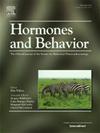草原田鼠择偶行为的性别差异
IF 2.4
3区 医学
Q2 BEHAVIORAL SCIENCES
引用次数: 0
摘要
基础和临床研究的证据表明,成人伴侣结合的广泛功能和健康后果。几十年来,对社会一夫一妻制草原田鼠(Microtus ochrogaster)的研究提供了有价值的机制见解,使成年配对形成和维持的神经分子基质。尽管这方面的文献增长迅速,但人们对配偶结合行为的终身发展和一夫一妻制大脑的组织知之甚少。为了描述草原田鼠能够配对的年龄,我们测试了处于幼年和成年发育阶段的雄性和雌性草原田鼠在同居48小时后是否会表现出对异性伴侣的偏好。我们发现,在青春期早期(P31-36)配对的雌性更喜欢与伴侣挤在一起,而不是与一个新的雄性同类,但这种选择性的社会偏好直到成年后才在雄性身上观察到(P60+)。此外,与雄性相比,雌性对配对伴侣的偏好程度更高,这表明该物种在配对结合的发育开始和强度方面存在明显的性别差异。确定性别特异性配对行为的典型发展轨迹,将有助于对年龄特异性社会依恋的神经科学和内分泌学进行新的探索。本文章由计算机程序翻译,如有差异,请以英文原文为准。
Behavioral sex differences in the developmental emergence and selectivity of partner preferences in prairie voles
Convergent evidence across foundational and clinical research has demonstrated the expansive functions and health consequences of adult pair bonding. For decades now, study of the socially monogamous prairie vole (Microtus ochrogaster) has provided valuable mechanistic insights into the neuromolecular substrates that enable adult pair bond formation and maintenance. Despite this rapidly growing literature, substantially less is known about the lifespan development of pair bonding behavior and the organization of the monogamous brain. To characterize the age at which prairie voles are capable of pair bonding, we tested if male and female prairie voles between juvenile and adult stages of development could exhibit an other-sex partner preference after 48 h of cohabitation. We found that females paired by early adolescence (P31–36) preferred to huddle with their partner over a novel male conspecific, but this selective social preference was not observed in males until adulthood (P60+). Further, the degree of preference for the pair bond partner was greater in females compared to males, suggesting that there is a robust sex difference in the developmental onset and strength of pair bonding in this species. Identifying the typical developmental trajectories of sex-specific pair bonding behavior will enable novel inquiries into the neuroscience and endocrinology of age-specific social attachments.
求助全文
通过发布文献求助,成功后即可免费获取论文全文。
去求助
来源期刊

Hormones and Behavior
医学-行为科学
CiteScore
6.70
自引率
8.60%
发文量
139
审稿时长
91 days
期刊介绍:
Hormones and Behavior publishes original research articles, reviews and special issues concerning hormone-brain-behavior relationships, broadly defined. The journal''s scope ranges from laboratory and field studies concerning neuroendocrine as well as endocrine mechanisms controlling the development or adult expression of behavior to studies concerning the environmental control and evolutionary significance of hormone-behavior relationships. The journal welcomes studies conducted on species ranging from invertebrates to mammals, including humans.
 求助内容:
求助内容: 应助结果提醒方式:
应助结果提醒方式:


